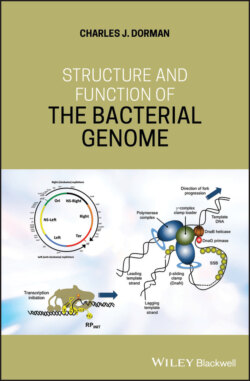Читать книгу Structure and Function of the Bacterial Genome - Charles J. Dorman - Страница 27
1.16 The Nucleoid
ОглавлениеA defining characteristic of prokaryotes is that they do not possess a membrane‐bound nucleus. Instead, prokaryotes have a nucleoid, a body within the cytoplasm that contains the genetic material but lacks a surrounding membrane (Piekarski 1937). The nucleoid is composed of the chromosome and associated molecules including RNA polymerase, DNA polymerase, DNA‐binding proteins, and RNA molecules (Dorman 2014b; Macavin and Adhya 2012). In electron micrographs of thinly sectioned bacteria, the nucleoid can be seen as an amoeboid shape surrounded by the electron‐dense ribosomes within the cytoplasm (Kellenberger 1952; Robinow and Kellenberger 1994). Staining of the DNA with 4′, 6‐diamidino‐2‐phenylindole (DAPI) has confirmed the presence of a zone around the nucleoid in E. coli and B. subtilis where translation can take place (Mascarenhas et al. 2001). While even more sophisticated imaging has improved our knowledge of the structure of the nucleoid, it has taken a multi‐pronged approach using a variety of techniques over several decades to bring about our current (but still incomplete) understanding of the bacterial nucleoid.
The chromosome is packaged within the bacterial cell in a conformation that permits gene expression and DNA replication to proceed. The 4.6 Mb circular chromosome of E. coli strain MG1655 has a circumference of 1.5 mm and, if opened out fully, a diameter of approximately 0.5 mm. In contrast, the bacterial cell is approximately 2 μm in length, 1 μm in diameter and has a volume of 1 fl, or 1 × 10−15 l (Dorman 2013; Kubitschek and Friske 1986). Understanding how the need to package the DNA efficiently is reconciled with the requirements of DNA replication, gene transcription, DNA recombination, and DNA repair is a major goal of research into the structure of the nucleoid.
